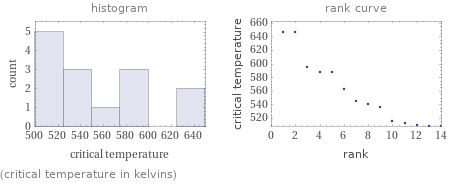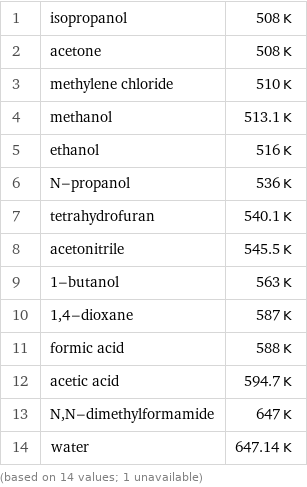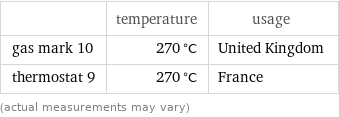Input interpretation

polar solvents | critical temperature
Summary

median | 542.8 K highest | 647.14 K (water) lowest | 508 K (acetone and isopropanol) distribution | | (based on 14 values; 1 unavailable)
Entity with missing value

dimethyl sulfoxide
Distribution plots

(critical temperature in kelvins)
Critical temperature rankings

1 | isopropanol | 508 K 2 | acetone | 508 K 3 | methylene chloride | 510 K 4 | methanol | 513.1 K 5 | ethanol | 516 K 6 | N-propanol | 536 K 7 | tetrahydrofuran | 540.1 K 8 | acetonitrile | 545.5 K 9 | 1-butanol | 563 K 10 | 1, 4-dioxane | 587 K 11 | formic acid | 588 K 12 | acetic acid | 594.7 K 13 | N, N-dimethylformamide | 647 K 14 | water | 647.14 K (based on 14 values; 1 unavailable)
Unit conversions for median critical temperature 542.8 K

269.6 °C (degrees Celsius)

517.4 °F (degrees Fahrenheit)

977 °R (degrees Rankine)

215.7 °Ré (degrees Réaumur)

149.1 °Rø (degrees Rømer)
Comparison for median critical temperature 542.8 K

57.8 K below melting point of lead (327.46 °C)

36.9 K above autoignition temperature of book paper in Ray Bradbury's famous novel (451 °F)

(24 to 50) K above autoignition temperature of paper (218 to 246 °C)
Corresponding quantities

Thermodynamic energy E from E = kT: | 47 meV (millielectronvolts)

Blackbody energy flux Φ from Φ = σT^4: | 4922 W/m^2 (watts per square meter)

Approximate luminous exitance from a planar blackbody radiator perpendicular to its surface: | 4.4×10^-8 lx (lux)
Nearest corresponding gas marks for median critical temperature 542.8 K (kelvins)

| temperature | usage gas mark 10 | 270 °C | United Kingdom thermostat 9 | 270 °C | France (actual measurements may vary)